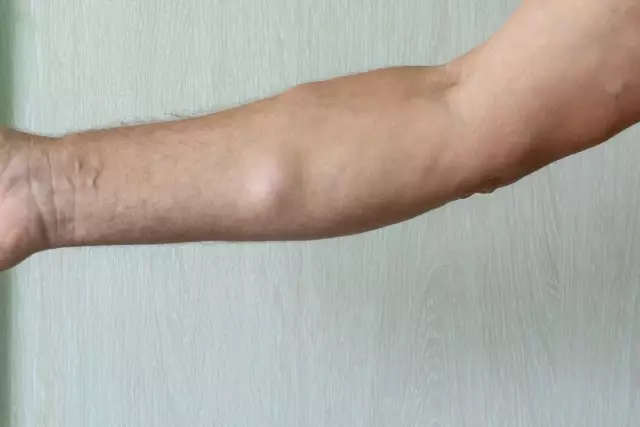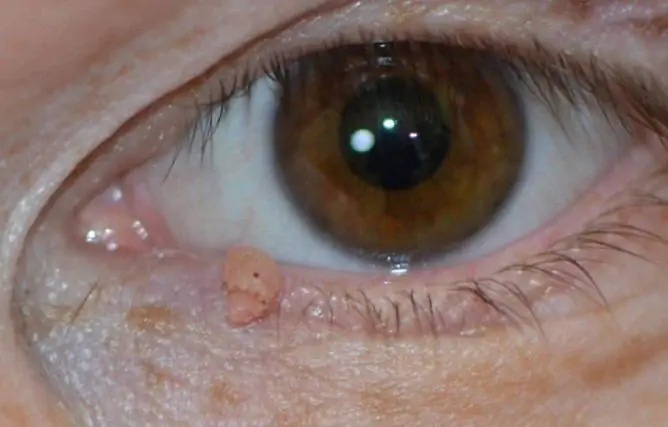- Author Rachel Wainwright [email protected].
- Public 2023-12-15 07:39.
- Last modified 2025-11-02 20:14.
Couperose
The content of the article:
- Causes of rosacea and risk factors
- Forms of rosacea
- Disease stages
- Symptoms
- Diagnostics
- Couperose treatment
- Possible complications and consequences
- Forecast
- Prevention
Couperosis is a vascular-skin pathology in which small blood vessels dilate, as a result of which their walls become thinner and lose elasticity.

Source: hairface.ru
According to statistics, couperosis of varying severity occurs in about 80% of people. Couperosis is most often diagnosed on the face in fair-skinned women over 30 years old. The likelihood of developing pathology increases with age: in patients over 65 years of age, couperosis is detected in about 75% of cases.
Causes of rosacea and risk factors
There are many known causes of rosacea, but the exact mechanism of the formation of pathology has not yet been identified.
The main causes of congenital rosacea include:
- congenital abnormalities of the blood vessels;
- ataxia telangiectasia (Louis-Bar syndrome);
- neoplasms formed as a result of an increase in capillaries.
Acquired rosacea is more common in people with thin, sensitive skin, and can be caused by the following pathologies:
- diseases of internal organs (more often - liver cirrhosis, hepatosis);
- endocrine disorders;
- autoimmune diseases (systemic lupus erythematosus, scleroderma);
- hypertension;
- skin diseases (rosacea);
- changes in hormonal levels (puberty, pregnancy, menopause);
- prolonged exposure to direct sunlight;
- bad habits, especially alcoholism;
- the use of a number of drugs (long-term use of hormonal contraceptives or their cancellation after long-term use, hormonal ointments and creams);
- exposure to stress, depression.
Risk factors include:
- demodicosis;
- sudden changes in ambient temperature;
- violation of the integrity of the skin;
- improper skin care (use of abrasive cleansers on sensitive skin, abuse of anti-aging treatments);
- exposure to the body of ionizing radiation, some chemicals;
- professional harm;
- inaccuracies in nutrition: unbalanced nutrition, deficiency of vitamins and minerals in the body, abuse of coffee, dark chocolate, spicy and hot foods.
At risk are people whose occupation is associated with prolonged exposure to the skin of the face of high and low temperatures and cold winds, for example, a metallurgist, bath attendant, cook, climber, etc. Couperose in children often develops against the background of regular overeating with insufficient physical activity.
Forms of rosacea
Couperose is divided into congenital and acquired, as well as true and false. The false one differs from the true one in that it appears periodically and does not spread to other areas of the skin.
Disease stages
In the clinical picture of rosacea, four successive stages are distinguished, each of which has distinctive features.
Symptoms
The onset of rosacea on the face may be preceded by sensations of itching and burning, tingling during washing, with minor changes in air temperature, any, even light touches to the face.
The first clinical manifestations of pathology usually occur after exposure to adverse factors; in rare cases, couperosis debuts for no apparent reason. The patient has hyperemia of the skin of the cheeks, chin, wings of the nose, and sometimes the neck (erythrosis). Skin manifestations may be accompanied by unpleasant subjective sensations (itching, tingling, burning). These symptoms last from several minutes to several hours.
At the second stage of rosacea, persistent redness, the appearance of pigmentation and the vascular network are noted on the affected skin areas.
With the transition of the pathological process to the third stage (congestive dermatosis), the skin at the site of the lesion becomes inflamed, areas of infiltration appear, the rest of the skin is pale, sometimes with a grayish tint. Pustular eruptions appear on the affected areas. In some patients, congestive dermatosis can form 20-30 years after the onset of the first clinical manifestations.
In the fourth stage, the skin coarsens and thickens, which is especially noticeable on the nose (the nose takes on a pineal appearance).
Diagnostics
For the diagnosis of rosacea, a dermatologist's consultation is required.
An objective examination, collection of complaints and anamnesis is carried out. In order to identify concomitant pathology, improve the effectiveness of treatment and prevent the development of exacerbations, a comprehensive examination may be needed, including determining the level of hormones, assessing the state of the liver, identifying markers of systemic diseases, etc.
For differential diagnosis with allergic diseases, a general blood test with counting the number of eosinophils is sufficient.
Couperose treatment
First of all, the influence of the factor that caused the development of the pathological process should be eliminated.
Drug treatment of rosacea consists in the external use of anticoagulants, drugs with antioxidant, venotonic, angioprotective and anti-inflammatory effects. Drug therapy of rosacea in children is carried out only when it develops against the background of diseases of internal organs and is aimed at eliminating the underlying pathology.
The main treatment of rosacea can be supplemented by herbal medicine (calendula oil, grape seed oil, blueberry, echinacea, myrtle, chestnut extract).
It is necessary to provide proper care for sensitive skin, which includes adequate cleansing, moisturizing, toning and nourishing the skin, as well as protecting it from ultraviolet radiation. Patients with rosacea are contraindicated to cleanse the face with too hot or cold water; you should also avoid using soap that dries out the skin. For cleansing the skin, it is recommended to use products based on vegetable oils.
After washing, you should not wipe your face with a towel, but gently blot your skin. Moisturizing and nourishing the skin with creams and serums enriched with vitamin complexes (vitamins C, E, K, P).
Do not use alcohol-containing products for skin toning. For this purpose, it is recommended to use preparations that include hops, juniper, chestnut, cypress, fir.
It is recommended to use creams with SPF filters to protect against UV radiation.
With rosacea, lymphatic drainage massage of the face, neck and décolleté is indicated. Mechanical face cleansing, abrasive and chemical peeling, laser resurfacing, vaporization (treatment of the skin with a jet of steam mixed with ozone and having a bactericidal effect) are contraindicated.
For the treatment of rosacea that has developed against the background of rosacea, sheets or masks with collagen are used (however, it is unacceptable to use brushes, brushes or sponges to apply and remove the mask in order to exclude traumatic effects on the skin).

Source: faceinfo.ru
Vascular correction is carried out by the method of electrocoagulation, which consists in the destruction of an enlarged blood vessel with an electric pulse passed through a thin needle. In this case, circulatory disorders in the vascular bed do not occur due to the presence of reserve capillaries, which are included in the bloodstream. Electrocoagulation first of all removes the largest of the affected vessels. The procedure is carried out in several stages, after removing rosacea using this method, subtle pigment spots and microscars may remain on the skin.
Minor couperosis can be removed with ozone therapy. The method consists in injecting an oxygen-ozone mixture into the lumen of the affected vessel through a microneedle. After this procedure, no scars and pigmentation remain.
Photo and laser therapy show good efficiency even in the case of significant lesions of the skin of the face, however, after treatment, point defects or areas of discoloration of the skin in the affected area may remain. Preliminary determination of the phototype and sensitivity of the patient's skin and the selection of a technique in accordance with the results obtained allow to avoid such consequences.
It is recommended to adjust the daily routine in such a way as to ensure a full night's sleep, as well as give up bad habits, visit tanning salons, baths and saunas, do not abuse decorative cosmetics, and stick to a diet. Pickled, spicy and spicy foods, hard cheese and other fatty dairy products, alcoholic beverages, and chocolate should be excluded from the diet. The diet includes vegetables (especially green ones), fruits, lean meats, dairy and dairy products of low fat content.
Possible complications and consequences
Couperosis can lead to permanent skin hyperemia (most often on the forehead, cheeks, chin), deterioration of the condition of the facial skin as a whole, and, as a result, a decrease in the psycho-emotional state.
Forecast
With timely diagnosis, adequate treatment and the implementation of medical recommendations, the prognosis for the acquired form of rosacea is favorable. Complete cure of congenital rosacea is not possible.
Prevention
In order to prevent the development of rosacea, a number of measures are recommended:
- timely correction of pathologies against which rosacea may develop;
- rational use of medicines;
- adequate facial skin care;
- avoidance of mental stress;
- balanced diet;
- rejection of bad habits;
- avoidance of occupational hazards;
- rational daily routine;
- sufficient physical activity;
- avoiding excessive sun exposure;
- avoidance of hypothermia and overheating, sharp changes in ambient temperature.
YouTube video related to the article:

Anna Aksenova Medical journalist About the author
Education: 2004-2007 "First Kiev Medical College" specialty "Laboratory Diagnostics".
The information is generalized and provided for informational purposes only. At the first sign of illness, see your doctor. Self-medication is hazardous to health!






